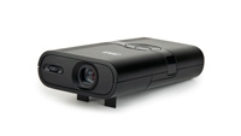Real-world Projector Considerations
Aug 17, 2009 9:32 AM,
By Jason Bovberg
For my recent home-theater build, I decided to take the plunge into the front-projection market. I did so completely blind, having no prior experience of my own or exposure to projector setups among friends or family. I was graduating from rear-projection, which—despite decent image quality—always bugged me with its idiosyncrasies: its sheer weight and bulkiness at even modest image sizes, its tendency to burn in images, its glossy surface that enjoyed reflecting any light outside of a completely dark room, and so on. I enjoyed my rear-projection behemoth for more than five years, but I was looking forward to graduating to the next level. I was ready to truly replicate the movie-theater experience, and front projection was the only way to do it.
So, where to start? My only experience with front-projection was glimpses as higher-end electronics stores: special, darkened rooms separated from the sales floor, booming with sound and strobing with images. I’d peek in and think, “Too rich for my blood.” Only five years ago, a quick glance at a projector price tag would verify my thought. These machines reached up into the tens of thousands of dollars. But as the years went by—and as the age of high-definition imagery dawned—I felt sure that front-projection technology would settle down and fall within the grasp of regular consumers like me.
Cut to 2009, when I was ready to embark on my dedicated home-theater project. I had the necessary space and had saved up some cash, so while construction began, I initiated my research into current models and trends. A website called Projector Central turned out to be an indispensable resource, offering detailed buying advice, measurement calculators, and a lively users forum to help me narrow my decision. I could type in the dimensions of my in-construction room (about 15’x 20’) and my desired screen size (between 100in. and 110in.) and get a list of projectors in my range. I could reduce the scope of those results by typing in favorite brands or price range. After some thorough research at Projector Central, I had five or six projectors that I wanted to consider.
Now that I had that handful, I sought to pick a winner. To do so, I moved to the even more lively home-theater community at the AVS Forum, which boasts a multitude of specific subforums that proved enormously helpful throughout my entire project. I found threads for every aspect of my theater build (electrical ideas, sound-proofing insulation, screen-wall architecture, recommended components, cosmetics), but most important, I found threads devoted to each of the projectors I had in mind. I took a day to read over voluminous comments from actual users of the machines, and I came to a decision that was perfect for the budget and the room: the Mitsubishi HC5500. The other projectors—Sony and Panasonic among them—had price or throw-distance limitations that directed me toward the Mitsubishi. I felt that I had done the necessary research to get the right projector for my theater.
After that, it sat in a box in my basement for two months, waiting its proper place on my theater ceiling. It just sat there, full of potential. I would stare at it, and I would pet it. I would whisper soft words into the partially opened box. I’d purchased the projector as part of a package deal that included a ceiling mount and a screen, and all the items were spread out before me. One day, I looked upon those items and experienced a bit of concern. Turns out, my chief mistake with the purchase was assuming that both of those free, included items would suit my room along with the projector. Wrong. Here’s why.
Over the space of two months, of course, I had ample opportunity to consider the ceiling mount, to open up the box and see how it would work. Immediately, I discovered that it was an extension mount, and worse, the extension arm couldn’t be worked around or discarded. My setup required a low-profile mount that would essentially place the projector directly at the ceiling. So much for that included item. I ended up throwing the mount onto Craigslist and began my search for a new mount. You can buy “official” mounts dedicated to particular projectors (for hundreds of dollars), but—always budget-conscious in this economy—I chose the eBay route and ended up with a perfect stainless-steel mount for less than $30. It attached perfectly to my ceiling beam and proved just as adjustable and malleable as I hoped.
As for the included screen, I had some doubts about its color. I remembered, in my research, that many of the projector’s users were engaged in a debate about the best screen to use with the Mitsubishi, and I didn’t remember finding any concrete answers. It was only after my theater was finished that I was able to see what kind of imagery the screen produced. After carefully calibrating the projector according to the settings recommended at Projector Central, I took in the image. My first impressions were that it looked outstanding. Over time, however, I began to be bothered by a certain dimness to the image that couldn’t be corrected with brightness controls. I was sure that the problem lay with the screen. I began researching other areas of the AVS Forum, and sure enough, I found threads dedicated to what kind of screen material to use in certain lighting scenarios. This was the kind of information that I had been blind to in my limited experience with front projection.
I’m guessing that most front-projection home theater setups are situated in rooms with some kind of ambient light—whether that be a window at the back of the room or an artificial light coming from another part of the area. Most people (according to my research) like to have the theater open and accessible to a bar area or recreation place. I preferred more of a screening room, completely closed off with total light control. For the former kind of open setup, a grayish (or higher-contrast) screen is preferable, in an effort to increase contrast under less-than-ideal lighting conditions. Gray screens tend to absorb ambient light and can help the projector with black levels. For my completely pitch-black screening room, a white screen would produce the most brilliant, high-contrast image.
Naturally, my freebie screen that came with the projector was gray. Don’t get me wrong: Even the gray screen produced an outstanding high-def image that I was able to live with for quite a while. Some movies—such as the already bright, perky Juno—looked downright outstanding, but others—such as the already dark, moody Curious Case of Benjamin Button—looked disappointingly muddy. But after contacting the manufacturer and switching the gray screen fabric for white, the image blasted dynamically off the screen, blazing with clarity and color.
So my virgin foray into front projection has resulted in spectacular results, but only after significant research and a little hands-on experience. If you’re in the market for a projector and are just starting out in this mode of home-theater enjoyment, I recommend due diligence. To get the image you want, you’ll need to have an understanding of exactly what your room requires.










